Gungjung tteokbokki is super FAST and so delicious! Ready in 20 minutes, this non spicy tteokbokki stir fry is our go-to for an easy weeknight dinner, with plenty of leftovers for lunch the next day.
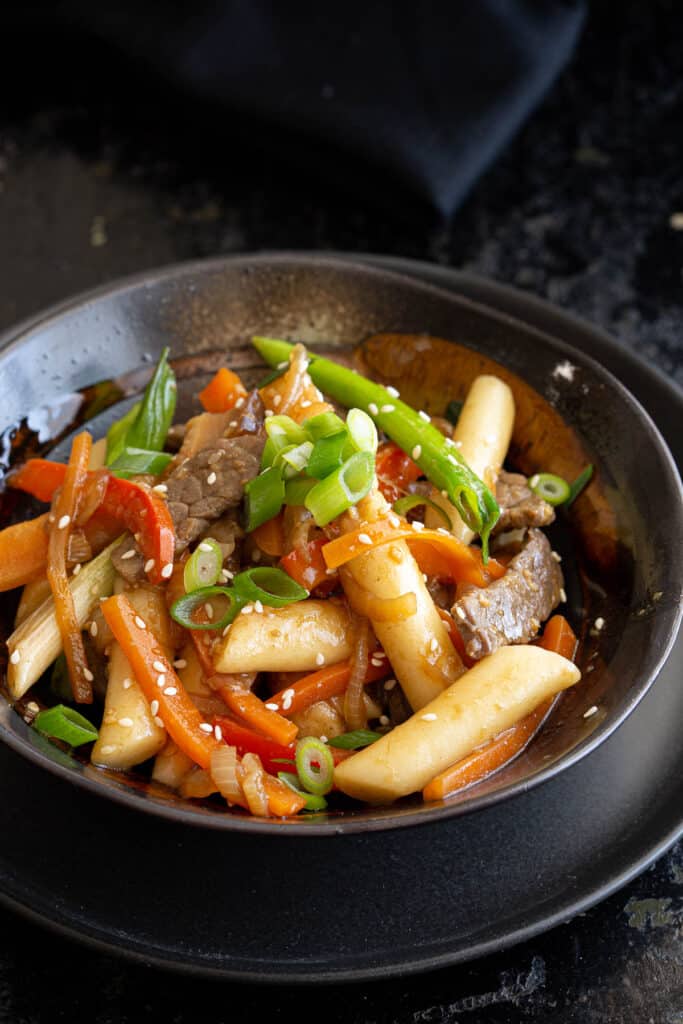
Why We Love This
Gungjung tteokbokki is such a quick and easy stir fry, perfect for those who want to enjoy delicious Korean flavours without the heat.
As a non spicy tteokbokki recipe, it’s filled with veggies, beef and rice cakes for a well rounded meal, and is a great option for kids and adults who prefer less spice.
The recipe is so easy to adapt to use up whatever you have in the fridge. If you’re vegan or vegetarian, use tofu as your protein or amp it up with extra mushrooms (shiitake or enoki go well) – no other swaps necessary!
Related: Tteokkochi / Dakgalbi / Rabokki
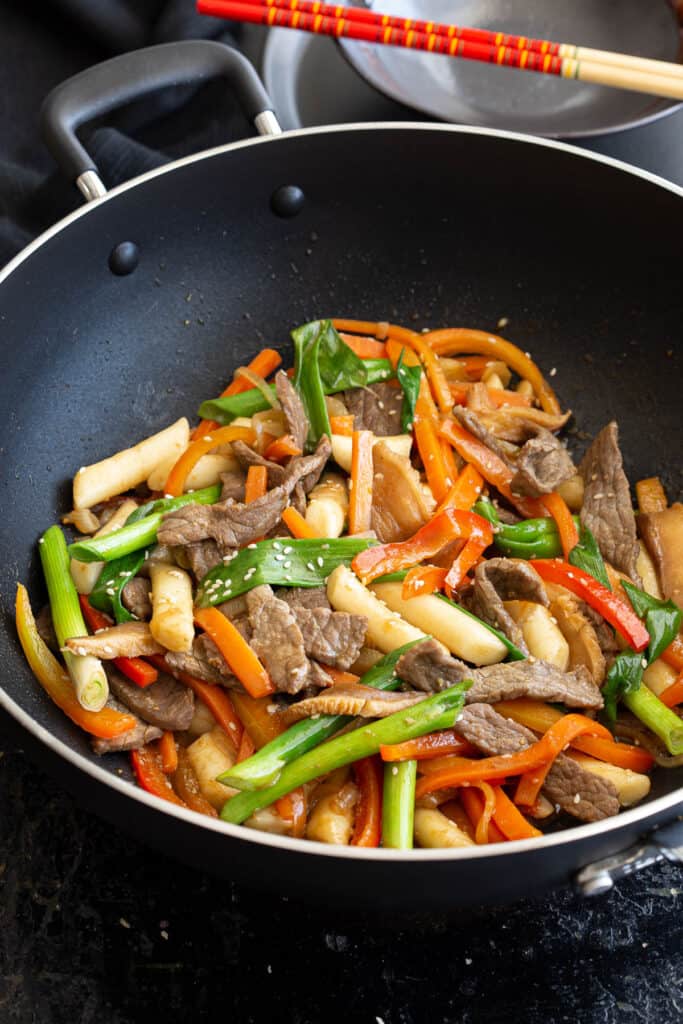
What is Gungjung Tteokbokki?
Gungjung tteokbokki (궁중떡볶이 / royal court tteokbokki) is one of the original Korean rice cake stir fry recipes!
It was first served in the Korean Royal Court (gungjung means palace or royal court) during the Joseon dynasty in late 19th century. Well before its counterpart (spicy tteokbokki infused with gochujang paste) became such a popular Korean street food dish.
This non spicy tteokbokki stir fry consists of thinly sliced beef, garaetteok rice cakes and vegetables seasoned with soy sauce, mirin, sesame and garlic. It’s savoury with a hint of sweetness, garnished with sesame seeds and sliced green onions.
Since it’s healthy and packed with veggies, it’s not considered a street food and is most often cooked at home or available in restaurants.
What You’ll Need
- Tteok / Korean Rice Cakes – You can use the long cylinder-shaped rice cakes known as garae-tteok, or flat oval-shaped rice cakes sliced diagonally. It’s more common to use the cylinders, but the flat rice cakes taste just as good (they’re more often used for rice cake soup). The best place to look for them is the fridge or freezer section of Korean convenience stores or Asian grocery stores, or you can make them at home if you have the time. If you can’t source them, leave them out and serve the stir fry over steamed rice or udon noodles.
- Steak – We use thin strips of sizzle steak but shabu shabu beef, sirloin or other lean beef cuts will also work well. Sub with chicken, pork or diced firm tofu.
- Shiitake Mushrooms – These add a delicious umami flavour to the dish. Use fresh or dried shiitake mushrooms reconstituted in warm water for 10-15 minutes before cooking. Sub with regular white or brown mushrooms, enoki, or leave them out.
- Veggies – Common ingredients include thinly sliced red or green bell pepper / capsicum, carrot, brown onion and spring onion / green onion. Use your favourite combinations or use up leftover veggies from the fridge – think bok choy, broccolini, zucchini, etc.
- Marinade – The marinade is made up of soy sauce (regular, not dark), mirin (sub with water and sugar), sesame oil, garlic and sesame seeds, seasoned with salt and black pepper to taste.
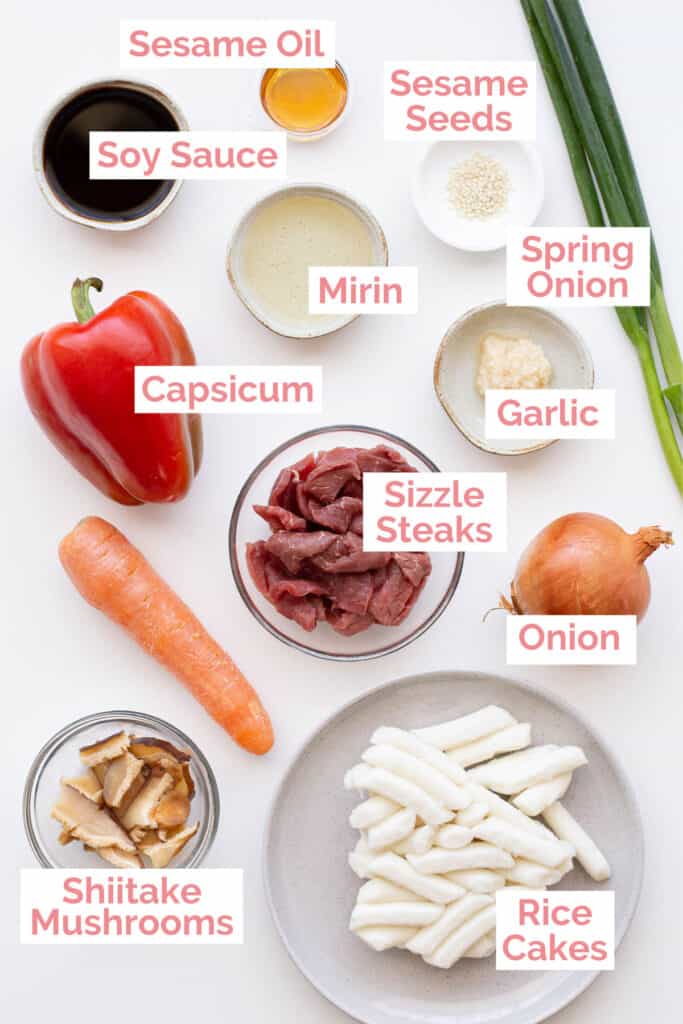
How to make Gungjung Tteokbokki
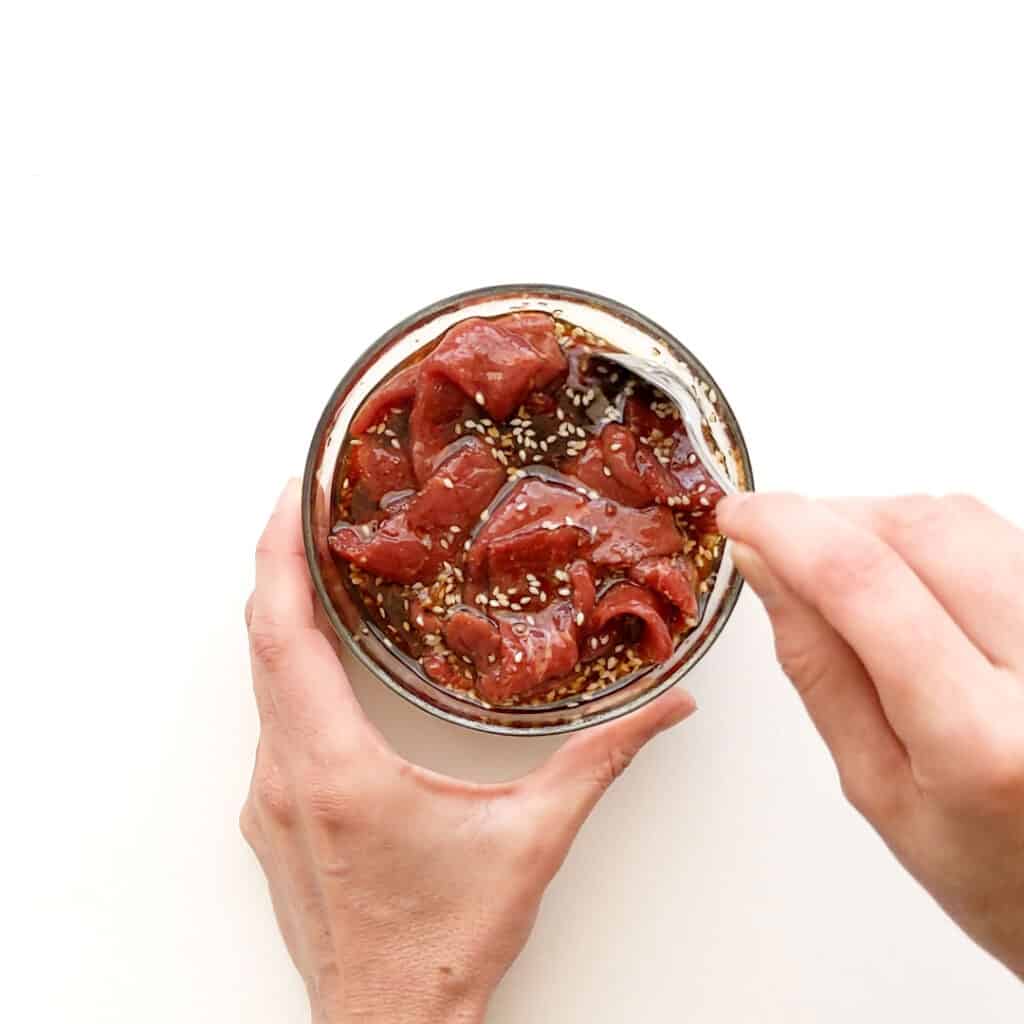
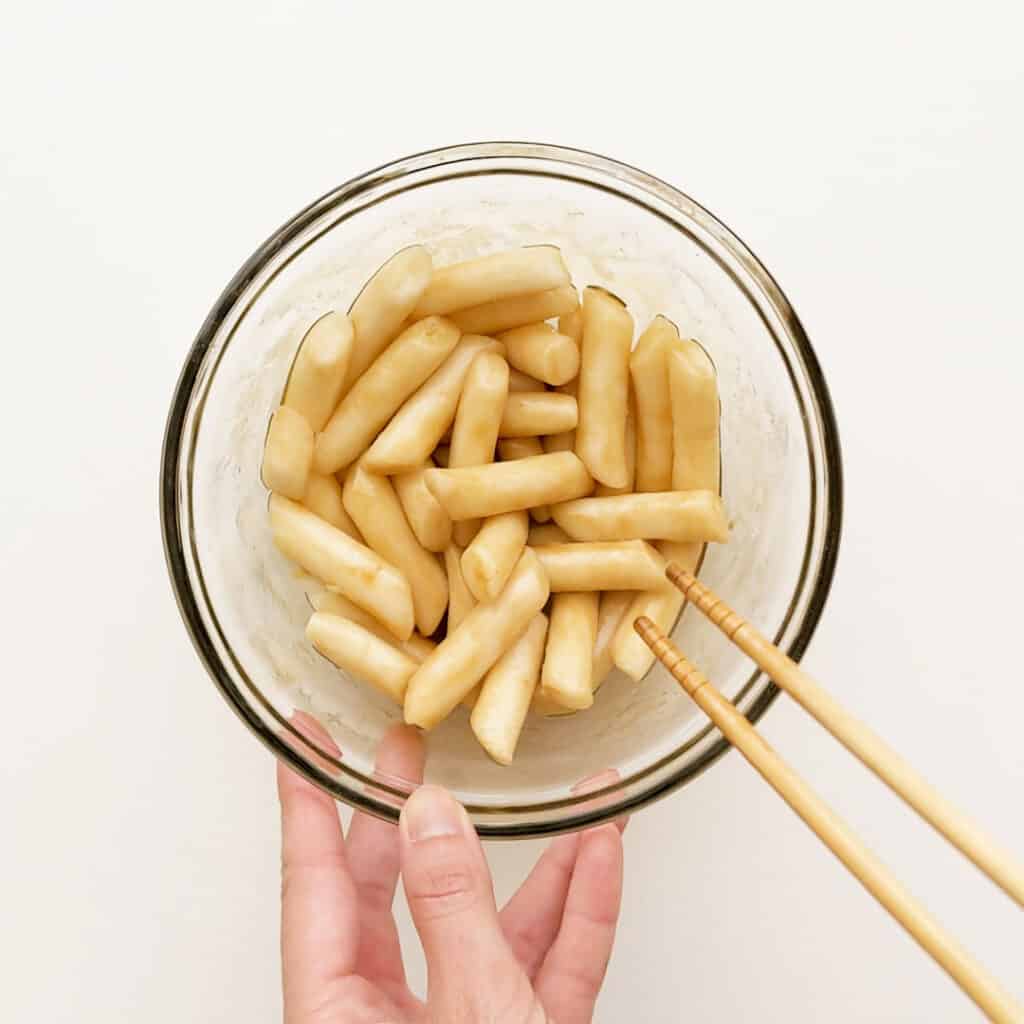
First, gather your ingredients: See recipe card below for measurements.
- In a medium bowl, pop in the beef slices along with the marinade (soy sauce, mirin, sesame oil, garlic, tbsp sesame seeds and salt & pepper to taste).
- While that marinates, bring the water to a boil in a wok. Add in the rice cakes and boil until they are soft and float (around 2-3 minutes, extra if frozen). Drain and transfer rice cakes into a small bowl. Pour over the soy sauce and sesame oil and mix.
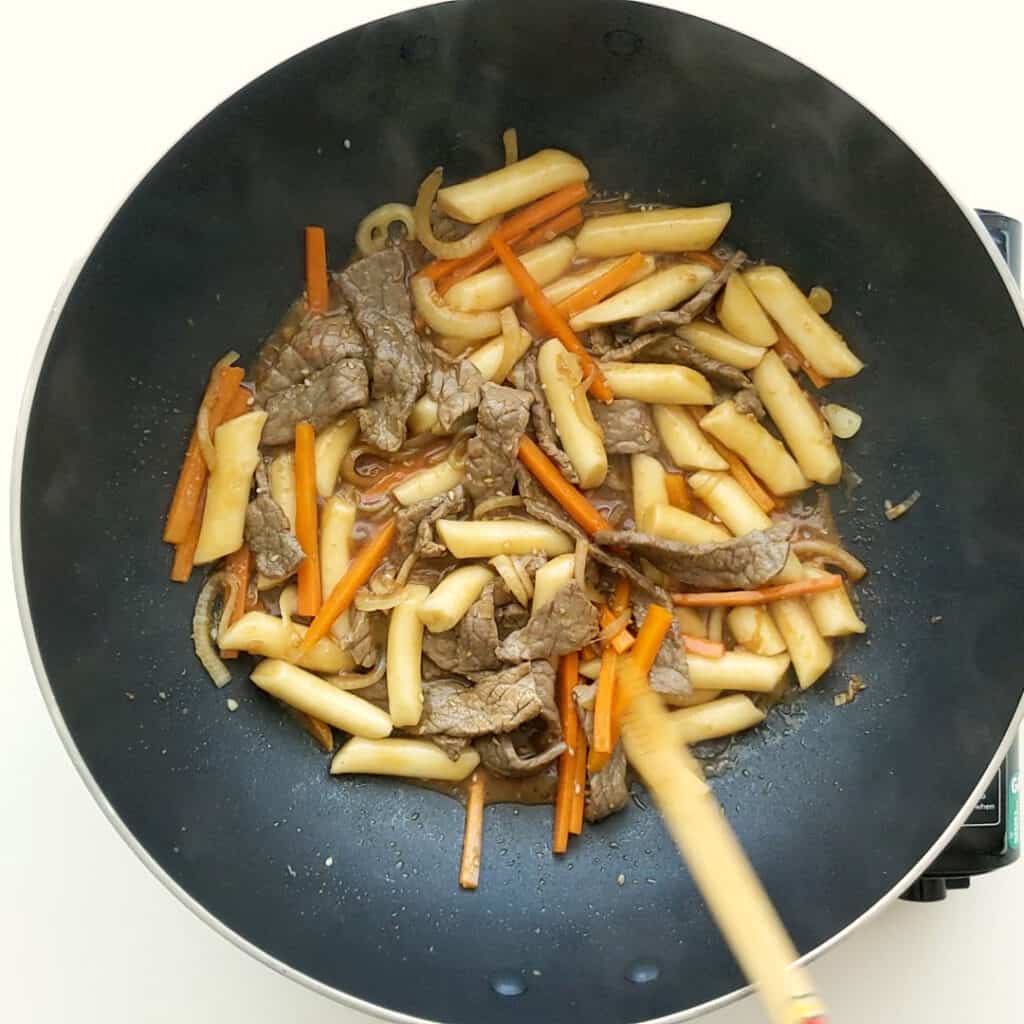
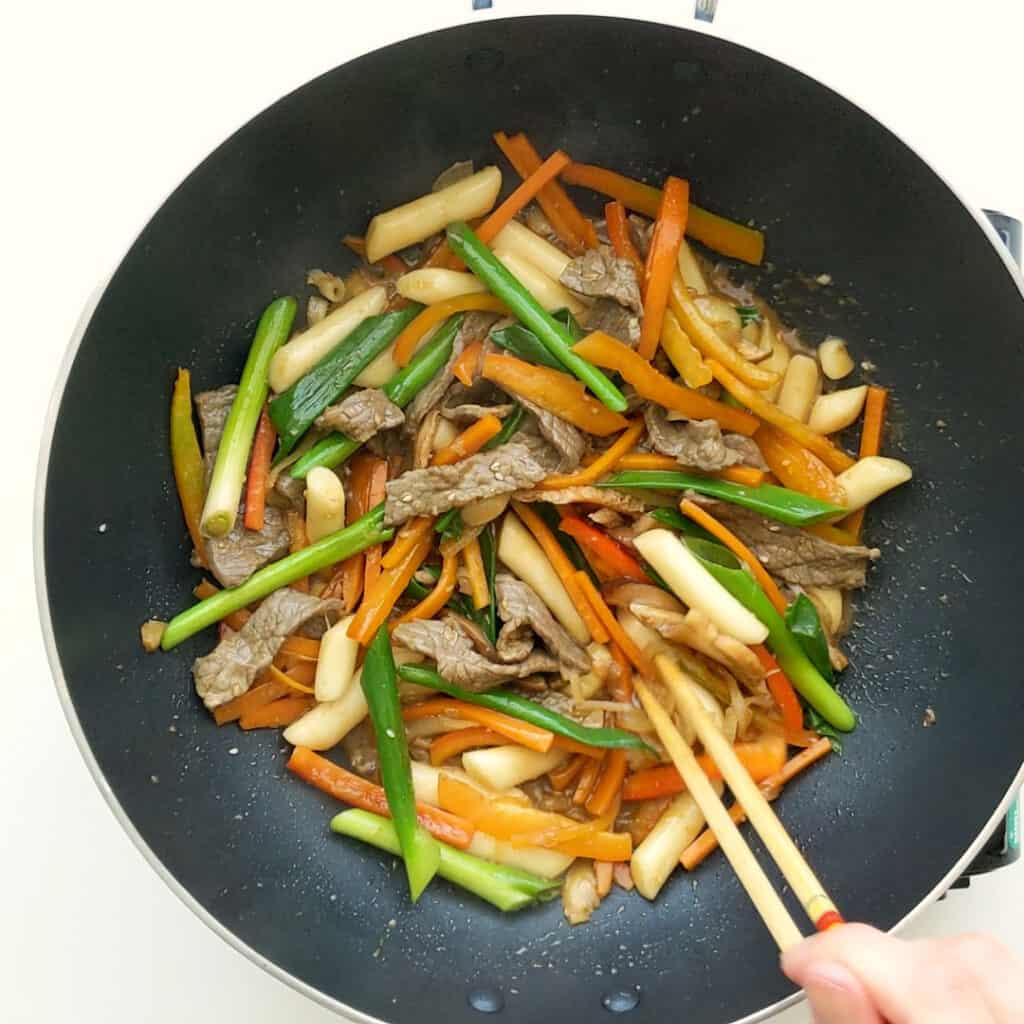
- In the same wok, heat the vegetable oil over a medium to high heat. Add the carrot and onion and fry for 2-3 minutes. Next add in the marinated beef and fry for a minute or two until mostly browned.
- Add in the marinated rice cakes, capsicum, shiitake mushroom, and green onion. Continue frying for another minute or two, then turn off the heat and serve.
Wandercook’s Tips
- Cooking Time – Thinner slices of meat and veggies will cook quicker, so you may need to adjust your cooking time accordingly.
- Storage – Store in the fridge for 2-3 days or in the freezer for 2-3 months. Why not cook up an extra big batch and portion out into airtight containers for easy lunches and dinners later on.
FAQs
Tteokbokki are rice cakes in a spicy gochujang sauce, whereas gungjung tteokbokki is the non spicy version with rice cakes in a soy and sesame infused sauce.
Gungjung tteokbokki is a full meal all on its own, but if you want to make it go a little further, you could serve it with plain rice (or kimchi fried rice for spicy heat) and a small bowl of kongnamul guk (bean sprout soup) or miso soup.
It would also be great with small bowls of banchan (Korean side dishes) such as seasoned spinach, bean sprout salad, kimchi or pickled garlic cloves.
Yes, that’s fine. You’ll be boiling them, which will help to break them apart as they thaw. If you find they’re still sticking together, add a dash of vegetable oil to the water to help them separate.
Korean rice cakes are a very versatile ingredient. For entrees, use them in tteokkochi rice cake skewers. For main dishes, they are great in traditional spicy tteokbokki, dakgalbi or Korean army stew. You can even have them for dessert! Fry them up in a pan, similar to tteokkochi, then slather in honey and a sprinkle of sesame seeds – yum! See our rice cakes guide for even more ideas.
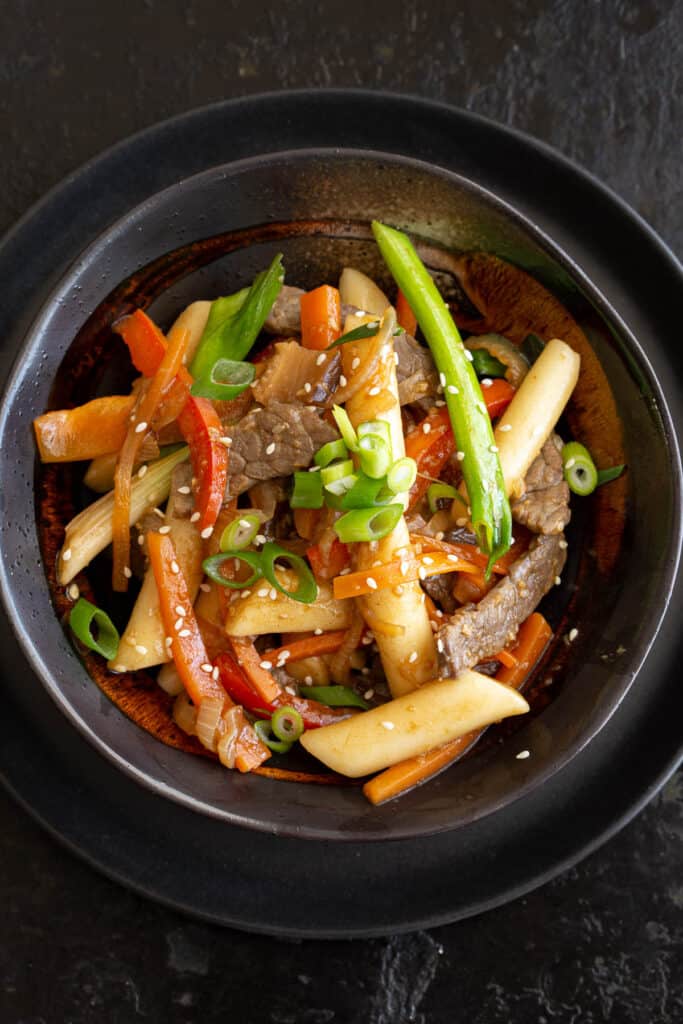
Variations
- Add Spice – Add a ½ – 1 tbsp of gochujang (chilli paste) or gochugaru (chilli powder) to the marinade. Or sprinkle the finished dish with rayu chilli oil to taste.
- Garnish Ideas – Top with extra sesame seeds or gomashio sesame salt, a splash of sesame oil or thin strips of fried egg yolk omelette. We love a combination of shichimi togarashi, aonori seaweed powder or furikake rice seasoning. You could even add a sprinkling or two of crispy fried shallots for flavour and texture.
- Alternate Marinades – Try it with homemade teriyaki sauce (soy and dashi marinade) or gochujang sauce (spicy marinade).
Try these amazing recipes next:
- Gochujang Pasta – Sweet spicy and super satisfying!
- Haemul Pajeon – Crispy fried Korean seafood pancakes.
- Gochujang Chicken Burgers – Our favourite Korean fusion burgers.
- Kkakdugi – Crunchy, spicy daikon kimchi, the perfect side dish for spice lovers.
- Korean Pickled Onions – So moreish and perfect for a burst of flavour between bites.
★ Did you make this recipe? Please leave a comment and a star rating below!
Equipment
Ingredients
- 1 L water for boiling
- 250 g Korean rice cakes (tteok) frozen or fresh
- 150 g sizzle steak sliced thin or shabu shabu beef
- 1-2 shiitake mushrooms sliced, sub with white mushrooms or enoki
- 1 capsicum / bell pepper red or green, julienned
- 1 carrot julienned
- 1/2 onion thinly sliced
- 3 spring onion / green onion chopped into 8 cm / 3 inch lengths.
- 1 tbsp vegetable oil
For the beef marinade:
- 2 tbsp soy sauce
- 2 tbsp mirin sub 1 tbsp rice wine and 1 tbsp sugar
- 1 tbsp sesame oil
- 1 tbsp garlic
- ½ tbsp sesame seeds
- Salt and pepper to taste
For the tteok marinade:
- 1 tsp soy sauce
- 1 tsp sesame oil
Instructions
- In a medium bowl, pop in the beef slices along with the marinade (soy sauce, mirin, sesame oil, garlic, sesame seeds and salt & pepper to taste).150 g sizzle steak, 2 tbsp soy sauce, 2 tbsp mirin, 1 tbsp sesame oil, 1 tbsp garlic, ½ tbsp sesame seeds, Salt and pepper
- While that marinates, bring the water to a boil in a wok. Add in the rice cakes and boil until they are soft and float (around 2-3 minutes, extra if frozen). Drain and transfer rice cakes into a small bowl. Pour over the soy sauce and sesame oil and mix.1 L water, 250 g Korean rice cakes (tteok), 1 tsp soy sauce, 1 tsp sesame oil
- In the same wok, heat the vegetable oil over a medium to high heat. Add the carrot and onion and fry for 2-3 minutes. Next add in the marinated beef and fry for a minute or two until mostly browned. Add in the marinated rice cakes, capsicum, shiitake mushroom, and green onion. Continue frying for another minute or two, then turn off the heat and serve immediately.1-2 shiitake mushrooms, 1 capsicum / bell pepper, 1 carrot, 1/2 onion, 1 tbsp vegetable oil, 3 spring onion / green onion
Video
Recipe Notes
- Tteok / Korean Rice Cakes – You can use the long cylinder-shaped rice cakes known as garae-tteok, or flat rice cakes sliced diagonally. It’s more common to use the cylinders, but the flat rice cakes taste just as good.
- Steak – We use thinly sliced sizzle steak but shabu shabu beef or stir fry steak will also work well. Sub with chicken, pork, diced firm tofu or leave it out.
- Shiitake Mushrooms – These add a delicious umami flavour to the dish. Use fresh or dried shiitake mushrooms reconstituted in warm water for 10-15 minutes before cooking. Sub with regular white or brown mushrooms, enoki, or leave them out.
- Veggies – Common ingredients include thinly sliced capsicum / bell pepper, carrot, brown onion and spring onion / green onion. Use your favourite combinations or use up leftover veggies from the fridge – think bok choy, broccolini, zucchini, etc.
- Marinade – The marinade is made up of soy sauce (regular, not dark), mirin (sub with water and sugar), sesame oil, garlic and sesame seeds, seasoned with salt and pepper to taste.
- Alternate Marinades – Try marinating the beef or your other chosen proteins in bulgogi sauce (soy based marinade) or gochujang sauce (spicy marinade).
- Cooking Time – Thinner slices of meat and veggies will cook quicker, so you may need to adjust your cooking time accordingly.
- Storage – Store in the fridge for 2-3 days or in the freezer for 2-3 months. Why not cook up an extra big batch and portion out into airtight containers for easy lunches and dinners later on.
Nutrition
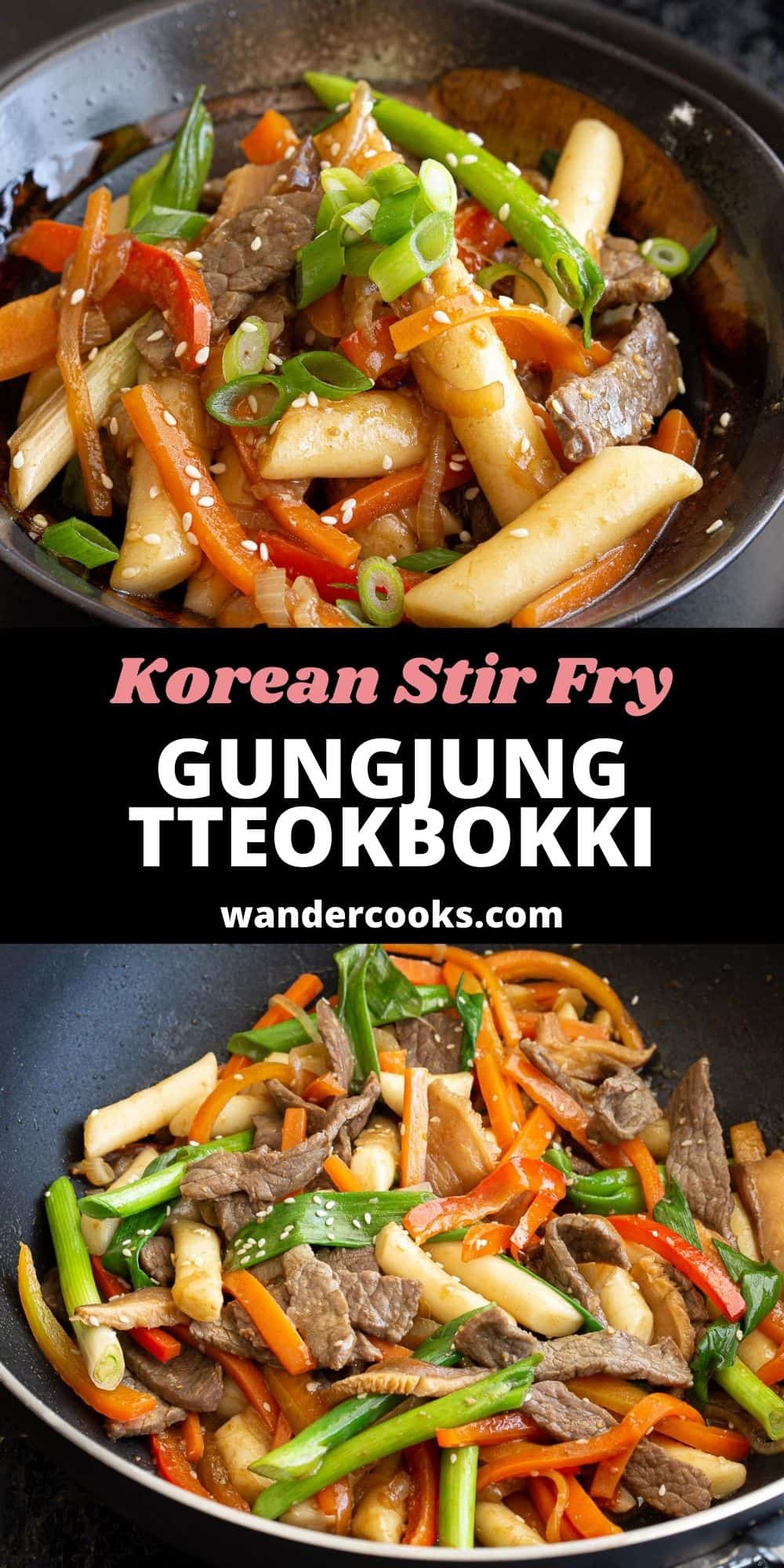

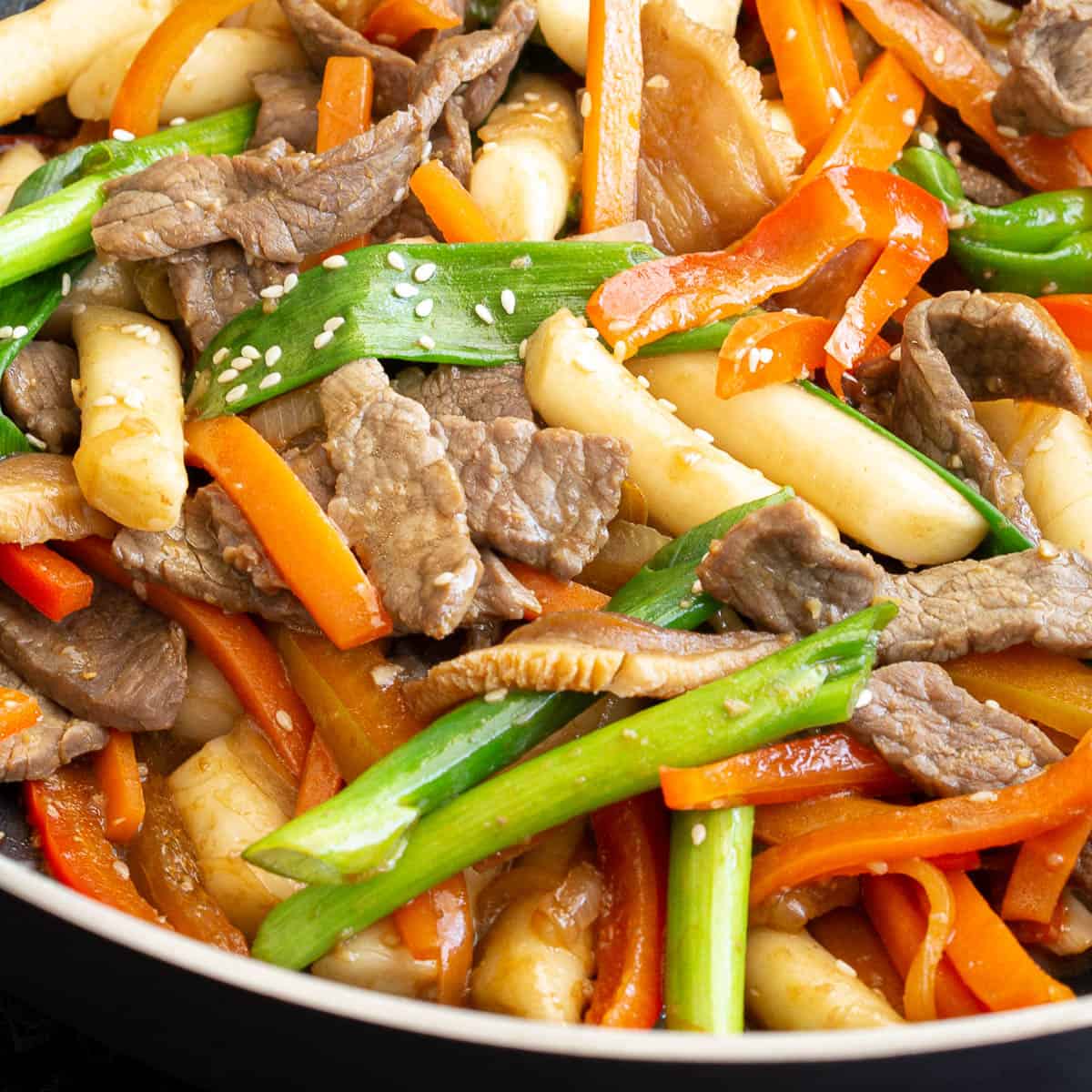



6 Comments
Danila Hernandez
11/02/2024 at 8:43 amAmazing recipe 💗💗💗
Wandercooks
12/02/2024 at 11:55 amThanks so much Danila! 😀
Bethany
03/11/2023 at 10:46 amThis was so delicious! I doubled the recipe- made me discover mama needs a bigger wok! 😅 thank you for the recipe !
Wandercooks
03/11/2023 at 10:48 amHaha! That is awesome Bethany! Nice work, and thanks for using our recipe. 😀
Jane
23/08/2022 at 8:14 pmKorean food is amazing and so is this recipe! I LOVE tteok and if you haven’t tried it you MUST!
This recipe is easy and versatile, change up the veggies but I think beef is the best protein to use. So yummy, filling and satisfying and the leftovers are amazing the next day too. I like to chop up some kimchi, mix with a touch of sesame oil and sugar and serve it on the side. This will be a regular on my menu. Fab!
Wandercooks
24/08/2022 at 9:21 amHey Jane, thanks so much for your feedback. Really love your idea with the kimchi, we’ll be giving that a go next round too. 😀